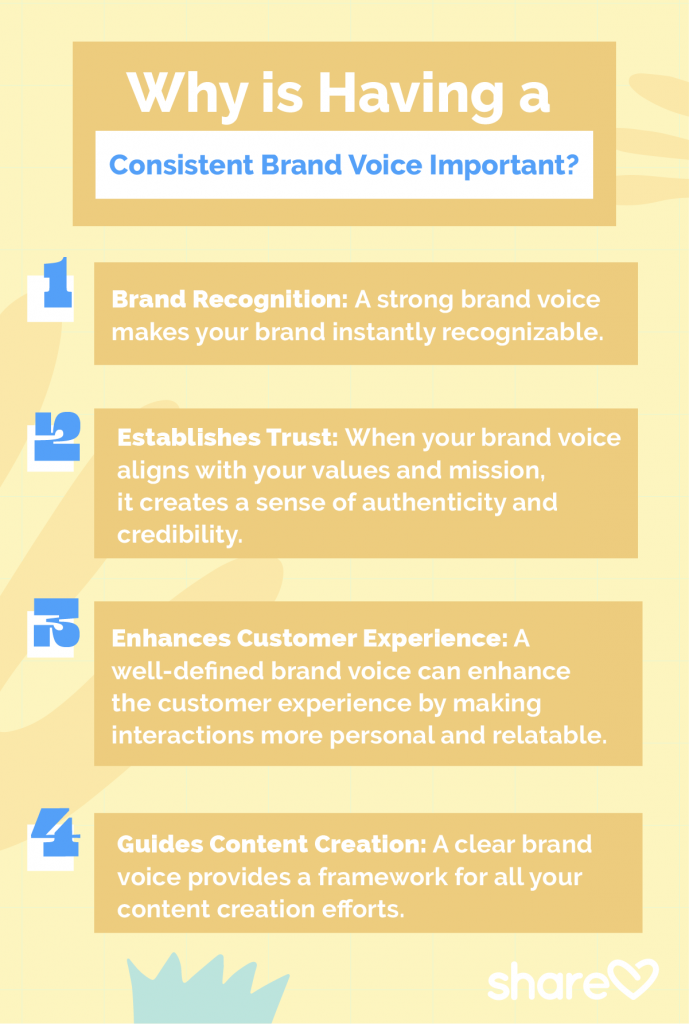In the digital world where users are constantly bombarded with content, carving out a distinctive identity is paramount for every brand. One way to stand out from the crowd and speak directly to your audience is by developing a unique brand voice. A well-crafted brand voice can help you connect with your audience on a deeper level, reinforcing your brand’s values and persona in every interaction. This guide will take you through the ins and outs of creating a strong brand voice on social media, providing practical tips and inspiring examples.
What is a Brand Voice?
A brand voice can be likened to the personality of your brand. It’s how you communicate with your audience across different mediums, and it should be consistent, unique, and authentic. It’s not just about what you say but how you say it. Your brand voice is expressed through the language you use, the tone of your communications, and the style in which you convey your messages.
Imagine your brand as a person at a social gathering. What kind of conversationalist would it be? Would it be the witty one with a dry sense of humor, the sage sharing pearls of wisdom, or the energetic chatterbox that keeps everyone entertained? The personality traits you assign to your brand would shape its voice.
Why is Having a Consistent Brand Voice Important?
A consistent brand voice plays a pivotal role in building brand recognition and trust. Here’s why it matters:
- Brand Recognition: A strong brand voice makes your brand instantly recognizable. This can be particularly valuable on social media platforms where users are exposed to a multitude of brands. With a consistent brand voice, your audience can easily identify your content amidst the digital clutter.
- Establishes Trust: When your brand voice aligns with your values and mission, it creates a sense of authenticity and credibility. This can foster trust and loyalty among your audience, encouraging them to engage more with your brand.
- Enhances Customer Experience: A well-defined brand voice can enhance the customer experience by making interactions more personal and relatable. It can help humanize your brand, allowing customers to connect on an emotional level.
- Guides Content Creation: A clear brand voice provides a framework for all your content creation efforts. It ensures that everyone in your team is on the same page, leading to more consistent and coherent content.

How to Build a Compelling Brand Voice
Crafting a compelling brand voice is a strategic process that requires a deep understanding of your brand and audience. Below are the steps to guide you through this process:
1. Understand your Brand
Your brand voice should reflect who you are as a brand. Start by revisiting your brand’s mission, values, and unique selling proposition (USP). What does your brand stand for? What makes it different? The answers to these questions can provide valuable insights into the kind of voice that would best represent your brand.
Additionally, consider the emotions you want your brand to evoke. For example, if you have an eco-friendly brand, you might want to create a sense of responsibility and community. If your brand offers luxury products, aim for an aura of exclusivity and elegance.
When thinking about your brand, also evaluate the competition. Knowing how other brands communicate can help you find a unique angle or positioning. For instance, if most competitors in your industry have a formal voice, maybe adopting a more approachable, friendly voice will help you stand out.
A good example of this is Dollar Shave Club, which made a splash with its humorous and irreverent brand voice. They positioned themselves as an alternative to the traditional, sometimes sterile brands in the shaving industry.
2. Know your Audience
Understanding your audience is crucial in shaping your brand voice. Conduct audience research to get insights into their demographics, preferences, needs, and language. The goal is to develop a voice that resonates with your target audience and speaks their language.
Beyond demographics, understand the psychographics of your audience. This involves knowing their beliefs, values, interests, and lifestyles. This information can be gleaned through surveys, focus groups, and social media interactions.
For example, a brand targeting Gen Z might use modern slang, memes, and a casual tone, while a brand targeting professionals may opt for a more formal and informational tone.
Moreover, localization is key if you have a global audience. Ensure that your brand voice takes into consideration cultural nuances and sensitivities.

3. Define your Brand Personality
Think of your brand as a person and assign it human attributes. Is it friendly or formal? Is it humorous or serious? The personality traits you choose will influence the tone, style, and choice of words in your communication.
Having archetypes can help to solidify your brand personality. Carl Jung’s archetypes like the Hero, Outlaw, Lover, or Everyman, can provide frameworks around which you can build your brand’s persona.
Also, think about how your brand personality will affect the customer experience. For instance, if you have a friendly, laid-back brand personality, make sure your customer service reflects this as well.
An example is Wendy’s fast-food chain, known for its sassy and humorous personality on social media, which helps it connect with a younger audience.
4. Develop a Brand Voice Chart
A brand voice chart is a useful tool to define and communicate your brand voice. It typically includes:
- Descriptive adjectives: Words that describe the tone and style of your brand voice.
- Do’s and Don’ts: Guidelines on what to include and what to avoid in your communication.
- Examples: Real-life examples showing how to apply your brand voice.
Furthermore, share this chart with everyone who creates content for your brand, so they are on the same page. This could include social media managers, copywriters, and customer service representatives.
Make sure to also include a section for feedback within the chart. Encourage your team members to suggest modifications that might improve the brand voice over time.
5. Be Consistent
Consistency is key to maintaining a strong brand voice. Ensure that your brand voice is applied consistently across all your content and communication channels.
Remember that consistency builds trust. When your audience knows what to expect from your communication, they’re more likely to form a bond with your brand.
However, be mindful of context. While the core voice should remain consistent, the tone may need to adapt to different situations. For instance, a playful brand voice might be appropriate for social media posts, but in a customer support scenario addressing a complaint, a more empathetic and understanding tone may be necessary.
Also, create content calendars and have regular meetings to ensure that every piece of content aligns with the brand voice. Conduct training for new team members to educate them on the importance of adhering to the brand voice.
An example of consistency is Coca-Cola. They have maintained a positive and uplifting brand voice focused on happiness and sharing for decades. This consistency has played a huge role in making it one of the most recognized brands in the world.
6. Review and Refine
Your brand voice is not set in stone. It should evolve with your brand and audience. Regularly review your brand voice to ensure it remains relevant and effective.
Use analytics to measure the impact of your brand voice. Are people engaging with your content? Are they sharing it and responding positively? These data points can give you an idea of what’s working and what isn’t.
Also, keep an eye on cultural trends and shifts within your audience. Society is constantly changing, and your brand voice needs to adapt to remain relatable.
Be open to feedback. Encourage your audience and team members to share their thoughts on your brand voice. Actively listening to feedback and making the necessary adjustments is critical in building an impactful brand voice on social media.

Tips for Developing Your Brand Voice
Creating a brand voice might seem daunting, but these practical tips can make the process smoother:
Align with your Brand’s Mission & Values:
Your brand voice should reflect your brand’s core beliefs and goals. It should be a true representation of what your brand stands for.
When developing a brand voice, consider how it can support your brand’s mission and values. For example, if one of your brand values is transparency, incorporate openness and honesty into your communication. This could mean being upfront about product ingredients, sharing behind-the-scenes content, or candidly addressing customer concerns.
Consider also creating a mantra or tagline that encapsulates your brand’s mission and values. This can serve as a guiding principle in developing your voice. For example, Disney’s mission statement is “to entertain, inform and inspire people,” and they employ an enchanting and magical brand voice that aligns with this.
Furthermore, aligning your brand voice with your mission and values can foster a deeper connection with your audience. When consumers see that your brand lives by its values, they are more likely to trust and stay loyal to your brand.
Speak your Audience’s Language:
Use words, phrases, and colloquialisms that resonate with your target audience. Speaking the language of your audience means understanding not just the words they use, but the context and meaning behind them.
For instance, a tech company targeting a tech-savvy audience might use industry jargon and acronyms. However, if their target audience is the general public, they will need to adopt a more simplified and explanatory language.
Localized content is also essential when engaging with a global audience. Language nuances, regional slang, and cultural references should be considered.
For example, HSBC Bank had to rebrand after their catchphrase “Assume Nothing” was mistranslated as “Do Nothing” in various countries.
Be Authentic:
Avoid trying to mimic another brand’s voice. Your brand voice should be unique and true to your brand’s identity.
In the age of social media, consumers are savvier and can easily spot inauthenticity. Crafting a genuine brand voice is not about jumping on every trend or mimicking what is popular, it’s about staying true to who you are as a brand.
For example, TOMS Shoes has a brand voice that is compassionate and community-focused, which is authentic to their mission of improving lives through business. Their communication consistently emphasizes positive social impact.
Encourage genuine interactions and engagements with your audience. Showcase real stories and experiences that reflect your brand values and mission.
Show Personality:
Don’t be afraid to show a bit of personality in your communication. A human touch can make your brand more relatable and engaging. Brands with strong personalities are memorable.
Think about incorporating humor, storytelling, or passion into your brand voice. However, it’s important that this personality aligns with your brand values and resonates with your audience.
Take, for example, the brand Innocent Drinks. Their communication is filled with wit, humor, and a casual tone. It not only reflects the brand’s fun nature but also makes them relatable and memorable to consumers.
Stay Consistent:
Consistency is crucial in maintaining a strong brand voice. Make sure your voice is consistent across all your content and communication channels. Having a consistent brand voice creates a recognizable identity.
Your brand voice must remain steady whether you’re posting on social media, sending out newsletters, or responding to customer inquiries. However, do not mistake consistency for rigidity.
As mentioned earlier, it’s important to adjust the tone based on context, while keeping the underlying brand voice consistent. For example, Apple maintains a sleek and innovative brand voice across all platforms. Whether it’s a product launch or a customer service response, they stay true to this voice.

Social Media Brand Voice Examples
Looking for inspiration? Here are some brands that have nailed their brand voice on social media:
Dove: Known for its empowering and body-positive messaging, Dove’s brand voice is uplifting and powerful, promoting self-love and acceptance.
Slack: This workplace communication tool uses a neutral and straightforward voice, emphasizing efficiency and directness.
Skittles: The candy brand uses humor and irreverence to create a fun and memorable brand voice. It’s a great example of a brand that doesn’t take itself too seriously.
Spotify: Spotify’s brand voice is funny, direct, and concise. Their clever use of humor and originality helps to create a unique connection with their audience.
Fitbit: Fitbit’s brand voice is encouraging and inspirational. It uplifts customers and encourages them to live healthier lives.
Building a strong brand voice on social media is an ongoing process that requires a deep understanding of your brand and audience. But with the right approach and a bit of creativity, you can create a brand voice that resonates with your audience and sets your brand apart. So, go ahead and give your brand the voice it deserves!






